In the whimsical world of stop-motion animation, Fantastic Mr. Fox stands out like a dapper fox in a tailored suit. But have you ever wondered how long it took to bring this furry masterpiece to life? The answer might surprise you, as the journey from script to screen is anything but ordinary. Crafted with meticulous care by the quirky genius Wes Anderson, the film’s production involved a blend of artistry, patience, and perhaps a few cups of strong coffee. It’s a delightful peek behind the curtain of animation magic that reveals just how much effort goes into creating a charming tale that resonates with both kids and grown-ups alike. Buckle up as we explore the timeline of this beloved film and uncover the secrets behind its enchanting creation.
How Long Did It Take to Make Fantastic Mr. Fox
Fantastic Mr. Fox, a stop-motion animated film, showcases the artistry of Wes Anderson in adapting Roald Dahl’s classic children’s book. The film includes a star-studded cast, featuring George Clooney, Meryl Streep, and Bill Murray, who lend their voices to memorable characters. This charming tale focuses on Mr. Fox’s cunning plans to outsmart three greedy farmers: Boggis, Bunce, and Bean.
Stop-motion animation, known for its labor-intensive process, plays a pivotal role in the film’s creation. Each character is crafted using meticulously designed puppets, which come to life through an intricate setup of scenes. Anderson and his team spent over two years developing the film, with production commencing in 2007 and concluding in 2009.
The attention to detail in every frame is evident. Frames are captured one at a time, with slight adjustments made to the puppets after each shot. This method resulted in a total of 24 frames per second for the desired fluidity of motion. Anderson’s focus on visual storytelling merges seamlessly with the vibrant aesthetic, emphasizing textures and colors reminiscent of Dahl’s original illustrations.
Music, composed by Alexandre Desplat, enhances the film’s whimsical tone, resonating well with audiences. Each note complements the narrative, creating an emotional backdrop for Mr. Fox’s adventures. Overall, Fantastic Mr. Fox remains a testament to dedication and creativity in animation, highlighting the extensive efforts invested in crafting a unique cinematic experience.
Production Timeline

The production timeline of Fantastic Mr. Fox showcases an elaborate process. Extensive planning took place before any filming began, emphasizing the film’s meticulous nature.
Pre-Production Phase
Pre-production spanned approximately 18 months. During this time, Wes Anderson and the team focused on script development and the adaptation of Roald Dahl’s work. They designed characters and constructed sets with various materials, ensuring a unique visual style. Extensive storyboard creation allowed the crew to map out each scene in detail. The team crafted over 200 puppets, each requiring precise attention for their movements and expressions.
Filming Duration
Filming took nearly 12 months, beginning in 2008 and concluding in 2009. Every scene involved meticulous stop-motion techniques, whereby animators captured one frame at a time. As a result, the crew achieved 24 frames per second, making the finished product fluid and engaging. Each day brought new challenges, with visual complexity requiring customized environments and adjustments to lighting. Animators collaborated closely, ensuring a cohesive look and feel throughout the film.
Post-Production Process
Post-production lasted around six months, concluding in late 2009. Editors combined all filmed sequences into a coherent narrative during this phase. Sound design played a crucial role, enhancing the film’s whimsical atmosphere with careful attention to audio effects. Alexandre Desplat’s musical score was recorded, lending an emotional depth to the story. Color grading and visual effects refined the film’s aesthetic while maintaining its stop-motion charm, resulting in a polished final product ready for audiences.
Challenges Faced During Production

The production of Fantastic Mr. Fox encountered several challenges that tested the team’s creativity and resilience.
Stop-Motion Techniques
Stop-motion animation demanded extensive time and effort. The filmmakers created each scene frame by frame, resulting in meticulous attention to detail. Setting up the puppets took significant time. Animators moved the puppets slightly for each shot, capturing 24 frames per second. Achieving fluid motion meant each character had to maintain consistent expressions and gestures. Errors during filming could require extensive reshoots. Finalizing shots necessitated patience and careful craftsmanship, showcasing the dedication involved in the animation process.
Weather and Outdoor Filming
Filming outdoors posed unique challenges for the team. Weather conditions had to align for optimal shooting, impacting the schedule frequently. Rain or wind disrupted set arrangements and would lessen the desired visual quality. The production team also faced difficulties with lighting, as natural light fluctuated throughout the day. Adjustments to the sets became essential to maintain continuity. Ensuring that the puppets remained unaffected by outdoor elements added complexity to the filming process. Despite these obstacles, the team adapted, seamlessly integrating the environment into the film’s whimsical aesthetic.
Impact on Animation Industry

Fantastic Mr. Fox significantly influenced the animation industry, particularly in stop-motion techniques. Its innovative approach demonstrated the potential of using detailed puppetry combined with advanced visual storytelling. Directors and animators noted its meticulous production methods, inspiring a wave of new projects utilizing similar craftsmanship.
The film’s success revived interest in stop-motion animation, showcasing its artistic merits during a time when computer-generated imagery dominated the industry. Many animators observed how Fantastic Mr. Fox redefined the boundaries of animated storytelling, integrating whimsical aesthetics with adult themes. This fusion appealed to diverse audiences, encouraging filmmakers to explore richer narratives in animated formats.
Wes Anderson’s distinctive visual style set new standards, prompting production studios to invest in ambitious stop-motion projects. Films like Coraline and The Boxtrolls followed suit, leveraging insights gained from Fantastic Mr. Fox to push creative limits. Collaborations between animators and designers flourished, with many adopting intricate design practices seen in Anderson’s work.
Industry recognition for Fantastic Mr. Fox included accolades and nominations that highlighted the craft of stop-motion animation. Both critics and audiences embraced the film’s uniqueness, elevating its status within animation circles. The narrative pacing and character-driven stories became benchmarks for artistic excellence, influencing filmmakers globally.
The film’s legacy continues to inspire emerging animators to experiment with stop-motion techniques. Students in animation programs reference Fantastic Mr. Fox as a key example of achieving artistic vision through teamwork and dedication. Festivals worldwide now celebrate films that honor this craftsmanship, tracing their roots back to Anderson’s groundbreaking work.
The journey of creating Fantastic Mr. Fox is a remarkable testament to the artistry and dedication behind stop-motion animation. With over two years of meticulous work the film showcases the intricate processes that bring characters to life. Wes Anderson’s vision combined with the talents of a dedicated team transformed Roald Dahl’s beloved story into a visually stunning cinematic experience.
This film not only captivated audiences but also reinvigorated interest in stop-motion techniques. Its legacy continues to inspire animators and filmmakers alike highlighting the importance of craftsmanship and creativity in storytelling. Fantastic Mr. Fox stands as a shining example of how passion and perseverance can yield extraordinary results in the world of animation.



